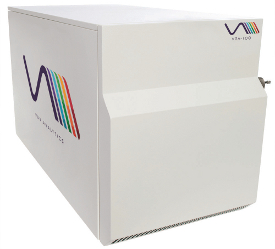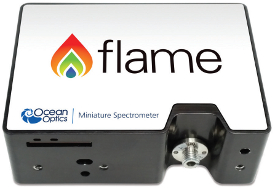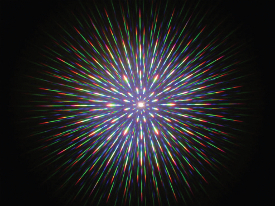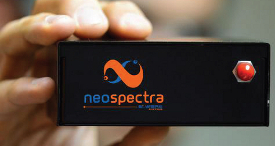Optical spectroscopy has seen a renaissance of sorts, with instrument development being driven in two distinct directions. Miniaturized, portable and handheld spectrometers have enabled users to take the laboratory to the sample, saving time and sometimes lives, and the desire for modern computer interfaces and increased instrument capability and sensitivity has precipitated the development of new benchtop and laboratory instruments. While the majority of the products discussed here push the boundaries of what is possible, a few have redefined them altogether.
 Figure 1 – VGA-100 vacuum ultraviolet absorbance detector from VUV Analytics.
Figure 1 – VGA-100 vacuum ultraviolet absorbance detector from VUV Analytics.Perhaps the most groundbreaking optical spectroscopy product on display at Pittcon 2015 was the VGA-100, the world’s first vacuum ultraviolet absorbance detector for gas chromatography from start-up company VUV Analytics (Austin, Tex.). While not strictly an optical spectrometer, the VGA-100 (Figure 1) expands the usefulness of absorption spectroscopic detection into the vacuum UV region (120 nm to 240 nm), which was previously limited to analysis by powerful synchrotrons.
This novel approach to GC detection provides qualitative and quantitative analysis with minimal calibration. The technique eliminates the ionization inefficiencies that can inhibit mass spectral analysis, while allowing unambiguous compound identification, including the majority of isomers.
Miniature optical spectroscopy
 Figure 2 – Ocean Optics flame spectrometer.
Figure 2 – Ocean Optics flame spectrometer.Miniature optical spectroscopy technologies continue to gain momentum.
Ocean Optics (Dunedin, Fla.) announced a new line of miniature spectrometers that provide thermal stability of 0.05 nm/°C from 200 nm to 850 nm and low unit-to-unit variability across the entire 190-nm to 1100-nm wavelength range. The flame spectrometer (Figure 2), which is fully configurable for use in absorbance, transmission, reflectance, irradiance and color applications, has interchangeable slits that allow users to adjust resolution and throughput on demand. It measures just 89 × 63 × 34 mm and weighs only 265 g.
 Figure 3 – SpectroBurst data produced by SpectroClick’s AAH-200a visible absorption handheld spectrometer.
Figure 3 – SpectroBurst data produced by SpectroClick’s AAH-200a visible absorption handheld spectrometer.The AAH-200a visible absorption handheld spectrometer from SpectroClick (Champaign, Ill.) employs consumer-grade megapixel camera technology to generate absorption spectra from 430 nm to 720 nm with an intensity dynamic range comparable to instruments with more expensive detectors. Using a series of stacked gratings, the solid-state instrument produces SpectroBurst data (Figure 3). No advance training is required. According to SpecroClick president Alex Scheeline, “The AAH- 200a will democratize spectrometry, making real-time analysis available for everyone, not just experts with expensive instruments.”
After winning the Pittcon 2014 Editors’ Gold Award for the DLP4500NIR digital micromirror device, Texas Instruments (Austin, Tex.) expanded its near-infrared (NIR) portfolio with a fully programmable microelectromechanical system (MEMS)-based DLP chipset that permits ultramobile analysis in the 700-nm to 2500-nm wavelength range. The chipset includes the DLP2010NIR chip, which utilizes the latest 5.4-μm pixel size to enable more compact optical designs. In addition, the new DLP NIRscan NANO evaluation module includes Bluetooth and Bluetooth low-energy functionality as well as an ARM Cortex microcontroller (ARM, San Jose, Calif.) for highly connected, wireless control.
 Figure 4 – Si-Ware Systems NeoSpectra sensor.
Figure 4 – Si-Ware Systems NeoSpectra sensor.Si-Ware Systems (La Canada, Calif.) featured MEMS-based NeoSpectra spectral sensors (Figure 4), compact and low-cost FT-NIR spectrometers based on semiconductor and MEMS microfabrication techniques. The devices deliver the same functionality as conventional benchtop FTIR spectrometers, with three configurations available between 1150 nm and 2500 nm.
Handheld spectroscopy
A number of new handheld spectrometers debuted at Pittcon.
Thermo Fisher Scientific (Waltham, Mass.) integrated FTIR and Raman spectroscopy into a single handheld instrument. With the Thermo Scientific Gemini analyzer (Figure 5), military personnel, bomb technicians, Hazmat teams and first responders can identify unknown chemicals and explosives more quickly and confidently. The analyzer takes advantage of the strengths of Raman and FTIR to address a broader range of samples than either technique alone.
 Figure 5 – Gemini analyzer from Thermo Fisher Scientific.
Figure 5 – Gemini analyzer from Thermo Fisher Scientific. Figure 6 – Bruker BRAVO handheld Raman spectrometer.
Figure 6 – Bruker BRAVO handheld Raman spectrometer.Bruker (Billerica, Mass.) introduced the BRAVO handheld Raman spectrometer (Figure 6) for the identification and quality control of raw materials in laboratory and industrial applications. It features innovative fluorescence mitigation technology that allows the measurement of a wider range of raw materials than earlier systems. The BRAVO is certified as a laser class 1M product, which does not require the use of laser safety equipment.
Upgraded benchtop spectrometers
Shimadzu Scientific Instruments (Columbia, Md.) was among a number of companies announcing a significant upgrade to their benchtop optical spectroscopy systems featuring state-of-the-art optics, electronics and optimized software.
 Figure 7 – RF-6000 spectrofluorophotometer from Shimadzu.
Figure 7 – RF-6000 spectrofluorophotometer from Shimadzu.The high-performance RF-6000 spectrofluorophotometer (Figure 7), which replaces the RF5301, provides the highest sensitivity and signal-to-noise ratio in its class (SN≥1000 rms, ≥350 peakto- peak), high-speed 3D scanning and an extended upper-wavelength range. The new UV-1280 monitored single-beam UV/VIS spectrophotometer from Shimadzu offers wavelength scanning from 190 to 1100 nm. The compact instrument finds application in the environmental, food and life science industries. Equipped with seven measurement modes, it can be used for a number of measurements, including photometric, spectral, kinetics, DNA/protein and high-level multicomponent quantitation.
Shimadzu’s UV-3600 Plus UV/VIS/NIR spectrophotometer is equipped with three detectors: a PMT (photomultiplier tube) for ultraviolet and visible regions and InGaAs and cooled PbS detectors for the near-infrared region. This combination ensures sensitivity across the entire measured wavelength range of 185 to 3300 nm, and significantly reduces noise level to ensure accurate measurements.
In addition to a wide range of optical spectroscopy products, Shimadzu introduced the ICPE-9800 series inductively coupled plasma-atomic emission spectrometers for the simultaneous analysis of trace and high-concentration samples. A vertically oriented plasma torch minimizes adhesion of samples on the torch walls, reducing carryover. The spectrometer supports switching between axial and radial observation to allow analysis of samples of different concentrations, and features a charge-coupled device (CCD) detector with one million pixels that can collect data for all wavelengths in a single run. Argon gas consumption is reduced by about 50%, leading to significant cost savings.
 Figure 8 – V-750 and V-780 UV/VIS/NIR spectrophotometers from JASCO.
Figure 8 – V-750 and V-780 UV/VIS/NIR spectrophotometers from JASCO.JASCO’s (Easton, Md.) product updates included benchtop instruments for UV/VIS/NIR, Raman and FTIR. The compact V-700 series comprise five UV/VIS/NIR spectrophotometers. The top-of-the-line V-780 (Figure 8) features a monochromator with dual gratings that are automatically exchanged to provide 1200 lines/mm for the UV-VIS region and 600 lines/mm for the NIR region. A PMT detector is included for the UV/VIS region and a high-sensitivity InGaAs photodiode detector for the NIR region.
The JASCO NRS 4100 series laser Raman spectrometer has a versatile three-laser system at 457, 532 and 785 nm with a standard measurement range of 8000 cm–1 to 50 cm–1. It is housed in a compact chassis measuring just 24 in. tall, 22 in. wide and 24 in. deep, and weighs 120 lb.
Five new instruments in the JASCO FTIR-4000/6000 series offer a highly stable corner cube interferometer and AccuTrac DSP technology to allow rapid and accurate tracking of mirror position and velocity. The FTIR-6800 provides maximum resolution of 0.07 cm–1 and a signal-to-noise ratio of 55,000:1.
PerkinElmer’s (Waltham, Mass.) new family of benchtop UV/VIS instruments—the Lambda 265, Lambda 365 and Lambda 465—are well-suited for materials testing, QA/QC and research and development. The compact, economical Lambda 265 incorporates a photodiode array detector and high-energy xenon flash lamp for fast and accurate results. The high-performance double-beam Lambda 365 provides variable spectral bandwidth capability from 0.5 nm to 20 nm. Because its software is 21 CFR Part 11 compliant, the system can support methods and applications in regulated environments. For high-end research and high-throughput applications such as dissolution testing and fast kinetics, the Lambda 465 combines a dual light source (tungsten and deuterium) and a photodiode array detector to allow the acquisition of full spectra from 1100 nm to 190 nm in as few as 20 milliseconds. With a resolution of 1 nm, the Lambda 465 meets the requirements of a number of pharmacopoeias, and its 21 CFR Part 11-compliant software makes it suitable for pharmaceutical applications.
Pharmaceutical companies can rapidly quantify the ratio of crystalline to amorphous active pharmaceutical ingredients (APIs) in tablets and capsules with no sample preparation using the TRS100 transmission Raman spectrometer from Cobalt Light Systems (Reston, Vir.). Sensitivity is greater than 10 times that of standard X-ray diffraction methodologies.
 Figure 9 – PANalytical’s Zetium XRF platform.
Figure 9 – PANalytical’s Zetium XRF platform.The Zetium XRF from PANalytical (Almelo, The Netherlands) (Figure 9), successor to the Axios platform, combines wavelength dispersive X-ray fluorescence (WDXRF) and energy dispersive X-ray fluorescence (EDXRF) capabilities in a single instrument. It can also include a small spot analysis tool for fast element distribution mapping as well as an X-ray diffraction (XRD) channel for free lime analysis.
Measuring both EDXRF and WDXRF simultaneously reduces analysis time by as much as half compared to running sequential analyses. Zetium is available in an Ultimate edition as well as five industry-specific configurations, which are optimized for applications in cement production, polymers, petrochemicals, metals and minerals.
The SPECTRO ARCOS high-resolution ICP-OES spectrometer from Spectro Analytical Instruments (Mahwah, N.J.) allows fast and convenient selection of either axial plasma or radial plasma observation without any optical compromise, a feature the company calls MultiView. An ORCA optical CCD system with a Paschen-Runge mount assembly delivers 8.5-picometer resolution in the 130–340 nm wavelength range. The UV-PLUS sealed optical chamber ends the need for the purging of argon or nitrogen gases. Air-cooled interface technology and a completely air-cooled generator eliminate the need for an external cooling system.
To meet the needs of heavy industrial users, Rigaku (The Woodlands, Tex.) developed the NEX QC QuantEZ series EDXRF spectrometers. The instruments deliver elemental measurements across a diverse range of matrices—from homogeneous liquids of any viscosity to solids, thin films, alloys, slurries, powders and pastes.
Conclusion
While combined separation and mass detection techniques still appear to steal the headlines, nondestructive optical methodologies are starting to make waves. Handheld devices eliminate the need to take samples to the laboratory for analysis, and instruments such as the VGA-100 vacuum ultraviolet absorbance detector for gas chromatography vie with mass spectrometry-based detection methods.
The number of new benchtop instruments introduced at Pittcon and the ever more sophisticated optical detection methods suggest a bright future for optical spectroscopy.
Matt Wilkinson, Ph.D., MBA, is an account director for Pinnacle Marketing Communications, Green Park House, 15 Stratton St., London W1J 8LQ, U.K.; tel.: +44 (0) 2084 296 548; e-mail: [email protected]; www.Pinnacle-Marketing.com